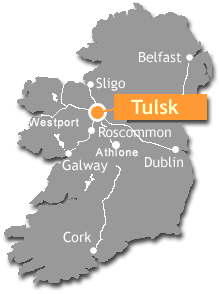Caran Fort, is recorded as Rath Carrain by John O'Donovan in 1848. The name, translated using comparable placename evidence countrywide, appears to refer to the curved nature of the eastern bank of the enclosure, if not the burial mound situated nearby. Interestingly, O'Donovan records in his 1837 Ordnance Survey Letters that 'Caran Fort... contained a cave'.
Caran Fort is a D-shaped enclosure with maximum external dimensions of 50m NNE/SSW and 48m WNW/ESE, with corresponding internal dimensions of 42m and 41m respectively. It is of clear ditch-and-bank construction. The banks average between 1.3m in height on the eastern side, with a width of 4m to the remaining ditch which is quite shallow containing a width of about 2m. There is no remaining evidence of the recorded cave, or souterrain, this, however, does not rule out its earlier presence.
 |
Satellite image of Caran Fort, with associated burial mound
to the north. (Courtesy of Google Maps)
|
The monument, if studied in isolation, does not seem to be of great importance. However, if this sie is considered with regard to the features that exists adjacent to it, namely the Bronze Age burial mound and bullaun stone, then a theory as to the possible function of the site becomes visible.
As with many of the site in the complex, Caran Fort seems to have provided some sort of ritual or ceremonial function. If the monument was at some point associated with a souterrain then it provides us with a certain amount of knowledge regarding its period of use, namely the first millenium AD. The bullaun stone, in this case a specimen of coarse-grained sandstone with a single carved hollow, has folkloric significance surrounding the use of any collected water in such stones for the purpose of healing. The origins of this tradition seem to disappear into prehistory eventhough their use continues well into the Christian period. It has also been suggested that the Bronze Age burial mound to the north of Caran Fort, in its location, mirrors the position of Dáithí's Mound on the south slope of Rathcroghan Mound. If this sort of dualism was deliberate, it provides an interesting note as to the way in which later interactions with the complex may have been organised. It, therefore, could be plausible that structures were constructed with specific thought given to the complex as a whole and each monument's place within.
Daniel Curley
 |
On this edited map, Caran Fort is marked with the black dot in the extreme north of the complex
|
- Waddell, J., Fenwick, J., & Barton, K., Rathcroghan: Archaeological and geophysical survey in a ritual landscape, (Wordwell, 2009)
- Hind, J. et al, 'The Rathcroghan Archaeological Complex Conservation Study' for Dept. of the Environment, Heritage and Local Government, July 2007



No comments:
Post a Comment